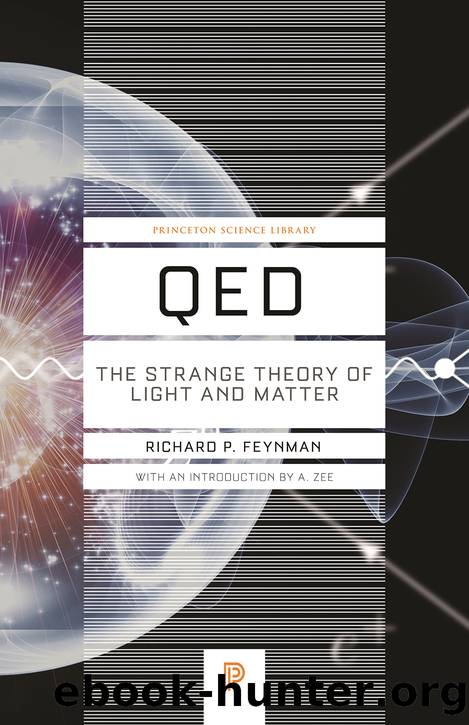QED by Richard P. Feynman

Author:Richard P. Feynman
Language: eng
Format: epub
Publisher: Princeton University Press
Published: 2013-06-14T16:00:00+00:00
1 The areas of the mirror whose arrows point generally to the left also make a strong reflection (when the areas whose arrows point the other way are erased). Itâs when both left-biased and right-biased areas reflect together that they cancel out. This is analogous to the case of partial reflection by two surfaces: while either surface will reflect on its own, if the thickness is such that the two surfaces contribute arrows pointing in opposite directions, reflection is cancelled out.
2 I canât resist telling you about a grating that Nature has made: salt crystals are sodium and chlorine atoms packed in a regular pattern. Their alternating pattern, like our grooved surface, acts like a grating when light of the right color (X-rays, in this case) shines on it. By finding the specific locations where a detector picks up a lot of this special reflection (called diffraction), one can determine exactly how far apart the grooves are, and thus how far apart the atoms are (see Fig. 28). It is a beautiful way of determining the structure of all kinds of crystals as well as confirming that X-rays are the same thing as light. Such experiments were first done in 1914. It was very exciting to see, in detail, for the first time how the atoms are packed together in different substances.
3 This is an example of the âuncertainty principleâ: there is a kind of âcomplementarityâ between knowledge of where the light goes between the blocks and where it goes afterwardsâprecise knowledge of both is impossible. I would like to put the uncertainty principle in its historical place: When the revolutionary ideas of quantum physics were first coming out, people still tried to understand them in terms of old-fashioned ideas (such as, light goes in straight lines). But at a certain point the old-fashioned ideas would begin to fail, so a warning was developed that said, in effect, âYour old-fashioned ideas are no damn good when â¦â If you get rid of all the old-fashioned ideas and instead use the ideas that Iâm explaining in these lecturesâadding arrows for all the ways an event can happenâthere is no need for an uncertainty principle!
4 Mathematicians have tried to find all the objects one could possibly find that obey the rules of algebra (A + B = B + A, A * B = B*A, and so on). The rules were originally made for positive integers, used for counting things like apples or people. Numbers were improved with the invention of zero, fractions, irrational numbersânumbers that cannot be expressed as a ratio of two integersâand negative numbers, and continued to obey the original rules of algebra. Some of the numbers that mathematicians invented posed difficulties for people at firstâthe idea of half a person was difficult to imagineâbut today, thereâs no difficulty at all: nobody has any moral qualms or discomforting gory feelings when they hear that there is an average of 3.2 people per square mile in some regions. They donât try to imagine the 0.
Download
This site does not store any files on its server. We only index and link to content provided by other sites. Please contact the content providers to delete copyright contents if any and email us, we'll remove relevant links or contents immediately.
The Complete Stick Figure Physics Tutorials by Allen Sarah(6638)
Secrets of Antigravity Propulsion: Tesla, UFOs, and Classified Aerospace Technology by Ph.D. Paul A. Laviolette(3448)
Thing Explainer by Randall Munroe(3327)
The River of Consciousness by Oliver Sacks(2992)
The Order of Time by Carlo Rovelli(2714)
I Live in the Future & Here's How It Works by Nick Bilton(2524)
How To by Randall Munroe(2474)
A Brief History of Time by Stephen Hawking(2473)
The Great Unknown by Marcus du Sautoy(2186)
What If?: Serious Scientific Answers to Absurd Hypothetical Questions by Randall Munroe(2170)
Blockchain: Ultimate Step By Step Guide To Understanding Blockchain Technology, Bitcoin Creation, and the future of Money (Novice to Expert) by Keizer Söze(2137)
Midnight in Chernobyl by Adam Higginbotham(2078)
Networks: An Introduction by Newman Mark(1998)
The Meaning of it All by Richard Feynman(1909)
Easy Electronics by Charles Platt(1864)
The Tao of Physics by Fritjof Capra(1848)
When by Daniel H Pink(1777)
Midnight in Chernobyl: The Untold Story of the World's Greatest Nuclear Disaster by Adam Higginbotham(1775)
Introducing Relativity by Bruce Bassett(1754)
